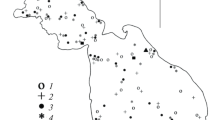Abstract
Spatial variations in the density and velocity fields have been observed in the Gareloch (Scotland) during surveys in 1987–1988 and 1993–1994. The variation of the density field has been analyzed on a variety of time scales from semidiurnal to seasonal in order to quantify effects caused by the forcing factors of tidal mixing, freshwater input, and wind. Initial results indicate that water density in the loch is controlled (to a major degree) by the freshwater input from runoff from the local catchment area and from freshwater entering on the flood tide from the Clyde Estuary. It is estimated that during winter periods the high freshwater flows from the rivers Leven and Clyde into the Clyde Estuary account for up to 75% of the freshwater creating the density structure in the loch. Analysis of long-term dissolved oxygen data reveals that major bottom water renewals occurred between July and January in the years 1987–1994. Major bottom water dissolved oxygen renewals have a general trend but during the year sporadic renewals can take place due to abnormal dry spells increasing the density of the water entering from the Clyde, or consistently strong winds from the north reducing stratification in the loch and producing better mixed conditions. Velocities vary spatially, with the highest velocities of up to 0.6 m s–1 being associated with the velocity jet effect at the constriction at the sill of the loch. Observed near-surface mid-loch velocities increased as the vertical density gradients in the upper layers increased. This indicates for the observed conditions that increased stratification in the upper layers inhibits the entrainment rate and hence rate of gain of thickness of the wind-driven surface layer, resulting in increased surface velocities for a given wind speed and direction. The main flow is concentrated in the upper 10 m and velocities below 10 m are low. Observed mean spring tide surface velocities are on average 30% greater than mean neap tide surface velocities.
Similar content being viewed by others
Author information
Authors and Affiliations
Additional information
Received: 22 May 1995 · Accepted: 23 August 1995
Rights and permissions
About this article
Cite this article
Lindsay, P. Temporal and spatial variations in density and velocity fields of the waters of Gareloch, Scotland. Environmental Geology 28, 201–212 (1996). https://doi.org/10.1007/s002540050094
Issue Date:
DOI: https://doi.org/10.1007/s002540050094




